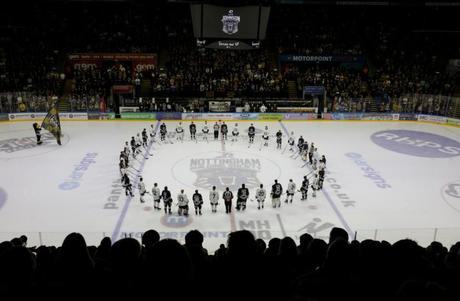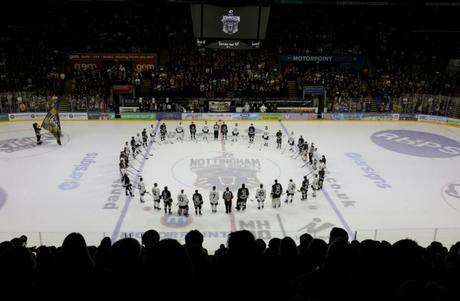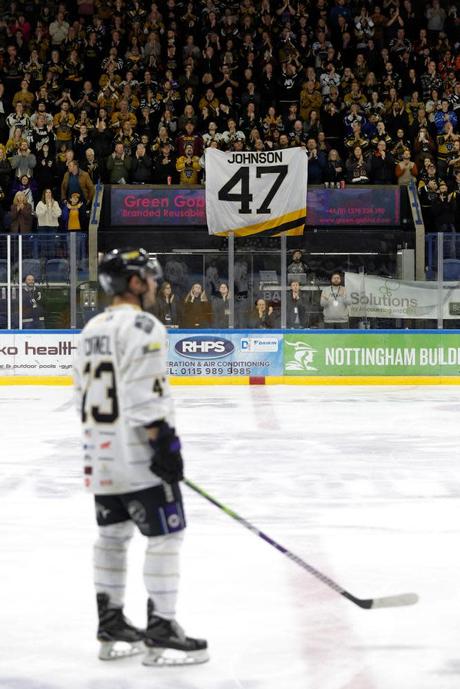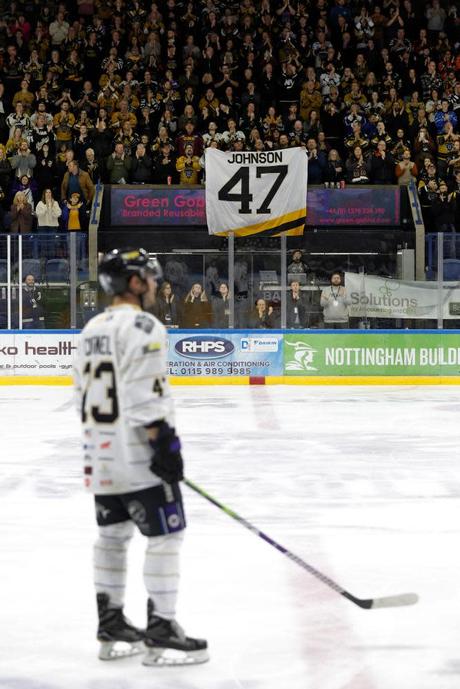Photo: Tom Jenkins/The Guardian
The flowers spread like bodies of water outside the National Ice Center, one bunch after another, red, pink, purple, white, yellow and blue, most wrapped in cellophane or paper, many with handwritten notes attached. Rest in peace, always our 47, thanks Adam. There were also drawings and framed photos, even a carved pumpkin. The pile became five, ten, twenty square meters; eventually so large that the Nottingham Panthers erected a fence and appointed a steward to watch over it. Last Saturday, bunches were still coming in in a steady trickle, new flowers on top of older ones.
The people who left them stood there for a while. No one seemed quite sure of themselves, no one really knew what to say or do. The first week after Adam Johnson died when he was hit by a skate during a game, no one knew when, where or even if the Panthers would play again, or how fans should act when or if they would finally perform. did. There was no precedent, nothing in the rules or in the competition rules. After twelve days, the Panthers announced that they would play a memorial match against the Manchester Storm on Saturday, November 18, three weeks after the accident.
A TV crew stood on one side of the arena. Usually they draw a big crowd, but this time no one stopped to listen or watch. The anchor was rehearsing a piece for the evening news and discussing the details. "Johnson, a 29-year-old forward from Hibbing, Minnesota, was involved in an on-ice collision with Matt Petgrave of the Sheffield Steelers..." The wall of the club shop was in shot and the slogan, Panthersland, was in the background . A stream of fans filed in quietly behind her. It was not just a competition, but a meeting. There were 6,500 people there, the largest crowd the club has had since before the pandemic.
They came not just from Nottingham, but from all over: London, Sheffield, Cardiff, Glasgow. There are 10 teams in the Elite Ice Hockey League, and more hockey, and more hockey fans, in Britain than anyone would suspect from the mainstream attention it receives. The club's regulars were surprised to see so many new faces in the crowd, but fans of other teams explained that they just felt they had to be there. They are a small community, but dedicated. They wore shirts with the names of their heroes on the back: Connolly 9, Betteridge 74, Critchlow 11. And now Johnson 47.
The story continues


His name was everywhere, on the jerseys of the players and referees, on the black armbands worn by the coaching staff. In the stands, fans beat a drum during warm-ups and chanted his name over and over to the rhythm of the Routers' Let's Go, while the players played rock, paper, scissors with the kids pressed against the glass. They broke off and gathered in a circle under the big screen as the club played a montage of Johnson's career, then banged their sticks on the ice as everyone else rose in a standing ovation when it was announced that the Panthers would win the jersey of Johnson would withdraw.
The game, the announcer explained, was intended as a celebration of Johnson's life and the game he loved. But the emotions were more complicated than they sounded, the atmosphere in the arena bittersweet. It mixed sadness, confusion, anger and dismay, and, it seemed to me, pride and rebellion. In recent weeks, this small club, with a backroom staff you can count on and a playing budget that would just about cover a top NHL player's salary for a fortnight, has been running sports bulletins around the world. A sport that received little attention suddenly discovered that there was more to it than anyone involved wanted.


News journalists have picked apart the lives of the people involved, with every little detail left for everyone to read about, and the incident itself has been studied endlessly by experts. But after all that talk and all that recording, the question remains: how can anyone really unravel what happened in those split seconds?
On November 14, the police arrested a man on suspicion of manslaughter. Privacy laws prevent the British media from revealing his identity. But during the match everyone was still talking about it. Meanwhile, the smokers who had gathered outside were walking around in circles. "We all have our opinions, I would never tell anyone theirs was wrong," and "at the end of the day Adam lost his life." It is rare for an on-the-ball incident to go to trial, especially in professional sports, otherwise any violation would be a legal action waiting to happen. Exceptions are only made if the behavior is 'sufficiently serious' to be considered criminal.
Nothing about it is simple.
At the same time, the club, the league and the sport itself are also under intense scrutiny. The International Ice Hockey Federation recommends that players wear neck protectors, but anyone over the age of 18 is not required to do so. The coroner's preliminary report was unequivocal "that future deaths may occur if neck gaiters or protectors are not worn." The uncomfortable truth is that these types of rules in sports often only change because it is already too late. The same happened in cricket, where neck guards were only introduced after Phillip Hughes was killed by a short ball in 2014. And even now there are countries - including Australia until last month - where they are still optional.
The EIHL has not yet committed to making players wear them, but the English Ice Hockey Association, which controls the sport at a lower level, has done so. Some players in the Panthers' memorial game had them on, while others did not. After seeking legal advice, the club declined to comment.


Johnson's death, against the wishes of his family, has become part of a culture war in sports. Petgrave is a black player in a predominantly white sport, and he is vilified online, often by racists who oppose ongoing efforts to make the game more diverse.
The match stopped in the 47th minute and an ovation broke out, which got louder and louder and louder, so that by the end you had the feeling that there were perhaps two, three or four, five times as many people participating; ultimately so loud that every hockey fan in England could have been part of it. The Panthers may be a small club by the standards of professional sports, but they are fiercely proud. They were founded in 1939 and have played on and off since then, while the competitions they participate in have fallen away and then been reborn or reconstituted.
When the memorial match was over, the players remained on the ice, skating lap after lap after lap of gratitude, as if they didn't want to leave the rink. The club goes on, the season goes on, the game goes on. Everyone perseveres, because that's what we always do. The spotlight will soon move on, the club and the sport will look a little different once it's gone; older, sadder, more scarred and more familiar with grief. If the authorities running it do the right thing, it will be safer too.
